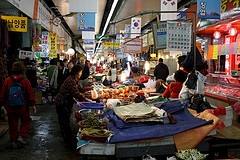
Korea’s inflation surges to three-year high of 5.3%
Blame the 11.4% rise in food prices for the higher inflation.
Morgan Stanley says higher food prices were mainly due to the aftermath of the record rainfall in July, which affected vegetable supplies.
Here’s more from Morgan Stanley:
| Korea's consumer price inflation rose to 5.3% YoY in August, the highest in three years. It was much higher than the consensus forecast of 4.8% YoY and also above the inflation figure of 4.7% in July. It was the eighth consecutive month that Korea's headline inflation figure has been above the Bank of Korea's target of 2%-4%. On a sequential basis, CPI was up 0.9% MoM in August, after the gain of 0.7% MoM in July. Food prices were the main driver for the higher inflation, up 11.4% YoY in August, vs 10.0% in July, or 3.0% MoM. The high food prices were mainly due to the aftermath of the record rainfall at end-July, which affected vegetable supplies. Transport prices also supported high inflation in August, after the expiration of the temporary gasoline price discount in July. Meanwhile, core inflation rose to 4.0% in August, vs 3.8% in July, the highest in 28 months. Food prices, transport prices and housing rents are drivers for inflation: Food prices (+11.4% YoY in August) saw the fastest growth in seven months. Food prices accounted for 14% of the total CPI basket, and it is the most volatile factor among all consumer products in the last year. Earlier in the year, the outbreak of foot-and- mouth disease and bird flu had affected pork, beef and chicken prices in Korea. In recent months, vegetable supplies were very much affected by the record rainfall at end-July, leading to a continued rise in vegetable prices. Meanwhile, transport prices also contributed to the high inflation in the month. Transport prices were up 7.8% YoY in August, vs 7.3% in July, or 0.5% MoM. Despite the easing of international oil prices in the last month on global demand concerns, Korea's domestic gasoline prices had remained high, due to the expiration of the gasoline price discount in July. Housing rents were the third driver for Korea's inflation, up 5.5% YoY in August, vs 5.2% in July, the highest in more than three years. Due to the sluggish property market, many Korean households choose to rent apartments to live in, rather than buying them, leading to strong demand in the rental market. Besides, because of the low interest rate environment, many landlords required higher jeonse, or lump-sum deposit on rental space, to compensate for the interest loss. The government has introduced measures to boost the supply of rental space in the market. However, it may still take a while for the measures to smooth the housing rents in Korea, in our view. Restaurant/hotel prices went up 3.8% YoY in August, higher than 3.5% in July, as the restaurants pass through the higher food costs to customers. Inflation in other categories remained relatively stable compared to the previous month. Is Inflation Peaking? Headline inflation in August was much higher than our and consensus expectations. However, we think Korea's inflation is likely to have peaked. Food prices remain the biggest driver for Korea's inflation at the moment, but food prices could decline quickly as harvests recover. The key swing factor for food prices in September is the Chuseok holiday, Korea's thanksgiving day, in the month. The major holiday in Korea could drive up food demand, but its impact on inflation would be short-lived. Coupled with easing international commodity prices, headline inflation could moderate quickly in 4Q this year, in our view. Meanwhile, core inflation may still climb on the back of high inflation expectations in Korea. The peaking of core inflation would usually lag the peak of the headline inflation by three to six months. We think growth concerns will outweigh inflation risks in the next few months and hence we expect the Bank of Korea to leave the interest rates unchanged in the monetary policy meeting this month, due to intensified external uncertainties. That said, we think there is still an upside risk for one last rate hike in this month, given that inflation remains above the central bank's target range. |
Photo from Luke Hoagland
























 Advertise
Advertise






